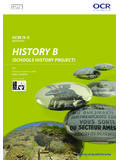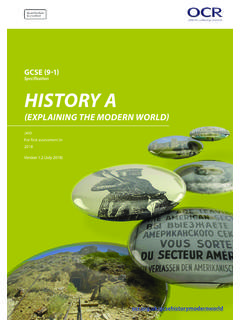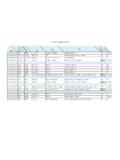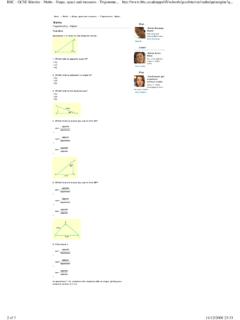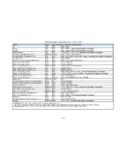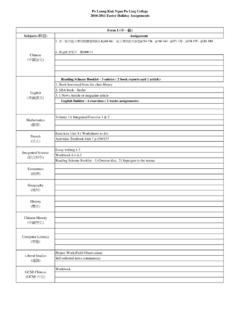Transcription of GCSE ART AND DESIGN - filestore.aqa.org.uk
1 SPECIMEN MATERIAL gcse ART AND DESIGN (Fine Art) To be issued to candidates on 2 January or as soon as possible after that date. All teacher-assessed marks to be returned to AQA by 31 May. Specimen 2018 Time allowed A preparatory period followed by 10 hours of supervised time Materials For this paper you must have: appropriate fine art materials and/or equipment Instructions Read the paper carefully. Before you start work, make sure you understand all the information. Choose one starting point and produce a personal response. You have a preparatory period to research, develop, refine and record your ideas.
2 Your work during the preparatory period could be in sketchbooks, journals, DESIGN sheets, separate studies or in any other appropriate form, including digital media. You must make reference to appropriate sources such as the work of artists, craftspeople, designers and/or photographers. These can be those named in your chosen starting point and/or other relevant examples. You must identify and acknowledge sources that are not your own. Following the preparatory period, you will have 10 hours of supervised time to complete your personal response. You may refer to your preparatory work during the supervised time, but the work must not be added to or amended once this time starts.
3 You must hand in your preparatory and supervised work at the end of each supervised session and at the conclusion of the 10 hours of supervised time. You must clearly identify work produced during the supervised time. The work submitted for this component can make use of digital and/or non-digital means, but must be produced unaided. Information Your work will be marked out of 96. Advice You should discuss your ideas with your teacher before deciding on your starting point. You should make sure that all appropriate materials and/or equipment which you might need are available before you start the supervised sessions.
4 2 Your work will be marked according to how well you have shown evidence of: Developing ideas through investigations, demonstrating critical understanding of sources. Refining work by exploring ideas, selecting and experimenting with appropriate media, materials, techniques and processes. Recording ideas, observations and insights relevant to your intentions as work progresses. Presenting a personal and meaningful response that realises intentions and demonstrates understanding of visual language. Choose one of the following starting points and produce a personal response.
5 1 Landscape The rural landscape has traditionally provided a rich subject for many British, Dutch and French artists. It continues to do so for contemporary artists such as John Virtue and photographer Jem Southam, whilst Charles Ginner, Edward Hopper and George Shaw have responded to the urban environment. Others such as Charles Sheeler, and the photographers Bernd and Hilla Becher and Raymond Moore, have found inspiration in industrial landscapes. Investigate appropriate sources, and develop your own response to a rural, urban or industrial landscape in your locality.
6 2 Trees Trees have often inspired artists. Diaz de la Pe a responded, in his paintings, to the effects of light and weather on trees located in the Forest of Fontainebleau. More recently, David Hockney has created works that interpret the appearance of trees when viewed at different times during the year. Sculptors David Nash and Giuseppe Penone have responded to the way trees grow. Investigate appropriate sources and create your own response to Trees. 3 Identity Artists have often explored their identity or that of other people through portraits. Goya and Holbein sometimes used the clothes people wore and objects with which they were surrounded as clues to their identities.
7 Frida Kahlo and Rembrandt painted self-portraits showing dramatic changes in the way these artists saw themselves. Yasumasa Morimura has recreated famous paintings in the form of photographs placing himself as a central character within each image. Investigate appropriate sources and produce your own response to Identity. 3 4 Telling stories Artists such as Lorenzo Ghiberti and William Hogarth often told stories in their work. Edward Hopper produced many paintings that hint at loneliness and isolation and present his personal vision of everyday life in America.
8 Developments in film, video and new media have enabled artists such as William Kentridge and Bill Viola to explore innovative ways to create visual stories. Investigate appropriate sources and produce your own response to: EITHER (a) a real event in your own life OR (b) a story you have read or written. 5 Mechanical Objects Marcel Duchamp, L szl Moholy-Nagy, and members of the Kinetic Art movement, created mechanical objects that explored the idea of movement. The sculptures of Jean Tinguely and installations of Rebecca Horn were often created to make mechanical noises.
9 Umberto Boccioni and Eduardo Paolozzi have responded to the world of mechanical objects. Investigate appropriate sources and make your own response to Mechanical Objects. 6 Mythical creatures Many artists throughout history have interpreted mythical creatures such as Cerberus, The Chimera and Medusa. In their sculptures, Pablo Picasso and Tim Shaw have responded to the story of the Minotaur. Sara Fanelli used collage to create monsters in her children s book Mythological Monsters of Ancient Greece . Leonora Carrington produced surreal paintings of fantastic characters and creatures drawing upon a variety of sources including Celtic mythology.
10 Investigate appropriate sources and produce your own response to Mythical creatures. 7 Changes The theme Changes can be interpreted in many ways. Make connections with sources to develop your own interpretation of Changes, or to respond to one of the following: (a) Changes that take place as plants grow and/or decay. (b) Changes that occur over a person s lifetime. (c) Changing tracks : a commission requiring an artwork to be displayed in the new foyer of a regional railway station. END OF QUESTIONS










